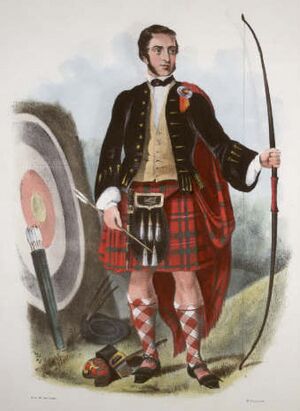Clan Mackinnon facts for kids
Quick facts for kids Clan MacKinnon |
|||
|---|---|---|---|
| Clann MacFhionghain | |||
| Motto | Audentes Fortuna Juvat (from Latin: "Fortune assists the daring"). | ||
| Slogan | Cuimhnich bàs Alpein (translation from Gaelic: "Remember the death of Alpin"). | ||
| Profile | |||
| Region | Inner Hebrides | ||
| Plant badge | Scots Pine. | ||
| Chief | |||
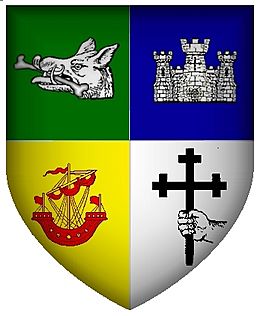 |
|||
| Madam Anne Gunhild MacKinnon of MacKinnon | |||
| 38th Chief of the Name and Arms of MacKinnon. (Mac Fhionghain) | |||
| Historic seat | Caisteal Maol | ||
|
|||
|
|||
|
|||
|
|||
The Clan MacKinnon (Scottish Gaelic: Clann MhicFhionghain) is a Highland Scottish clan from the islands of Mull and Skye. These islands are part of the Inner Hebrides in Scotland.
Many people believe the clan started with the ancient Dalriadic Gaels. Some historians, like W. F. Skene, thought the MacKinnons were one of the seven clans of Siol Alpin. This group believed they were all related to Alpin, who was the father of Cináed mac Ailpín. Cináed mac Ailpín was once thought to be the first King of Scots. Another idea is that Clan MacKinnon might be related to Saint Columba, a famous Irish saint. This is because the MacKinnon Arms show the hand of a saint holding a cross. Also, several MacKinnons were important religious leaders (abbots) on the island of Iona.
We don't know much about the clan's very early days. They likely worked for the powerful Lords of the Isles. When the Lordship of the Isles ended in 1493, the clan became more independent. They sometimes fought and sometimes allied with other clans like the MacLeans and MacDonalds. The MacKinnons supported the Jacobites in the 1600s and 1700s. It's said that the clan chief helped Bonnie Prince Charlie escape to France. Because they supported the Jacobite uprising in 1745, the MacKinnon chiefs lost their old clan lands.
Discovering Clan MacKinnon's Past
Tales and Legends of the Clan
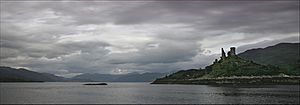
A famous legend says that Caisteal Maol castle, near Kyleakin, was built by a Norwegian princess called Saucy Mary. She married Findanus, who was believed to be an ancestor of Clan MacKinnon. The princess collected tolls from ships sailing through the narrow waters near the castle. To make sure ships paid, a chain was stretched across the water. When she died, she was buried on Beinn na Caillich mountain. The clan is also said to have beaten the Vikings in a battle at Goir a' Bhlair, on the slopes of Beinn na Cailleach.
Understanding the MacKinnon Name
The name MacKinnon comes from the Gaelic words Mac Fhionghuin. This means "son of Fionghuin". The name Fionghuin means "fair born" or "fair son". You can find this name in old texts like the Book of Deer. Sometimes, the name MacKinnon can also come from Mac Ionmhuinn, which means "son of the beloved one". Because of this, some people with the last name "Mackinven" changed their name to Love or Low. However, most people named Love or Low are not related to the MacKinnons.
MacKinnons and Robert the Bruce
The Collins Scottish Clan & Family Encyclopedia says that the MacKinnons helped Robert the Bruce. He was a fugitive (someone running away) at the time. After Bruce won the Battle of Bannockburn in 1314, the MacKinnons were given land on the Isle of Skye. The MacKinnon chiefs then lived at Dunringall Castle and were known as "of Strathardale".
Early Days of the Clan
Not much is known about the clan's very early history. The MacKinnons were closely connected to the powerful Lords of the Isles. Because of this, they didn't have much independent history at first. When the Lordship of the Isles ended in the 1490s, the clan finally became more independent. However, Clan MacKinnon was always a smaller clan and never became very powerful.
An early record of the MacKinnons shows Lachlan Makfingane witnessing an important document in 1409. Later, in 1467, Lachlann M'Fynwyn de Myschenys also witnessed a document from the Lord of the Isles. An old manuscript from the 1600s says that the MacKinnon chief was responsible for making sure weights and measures were correct in the Lord of the Isles' council.
The chief's crest shows a boar's head holding a deer's leg in its mouth. A MacKinnon legend explains this crest. A MacKinnon was hunting on Skye and spent the night in a cave. While cooking deer meat, a wild boar attacked him. The MacKinnon bravely shoved the deer's leg into the boar's mouth, holding it open, and then killed the animal.
Religious Ties to Iona

The early clan had a strong connection to the religious community on the small island of Iona. Saint Columba founded the abbacy (a type of monastery) on Iona in 563. Many leaders (abbots) of Iona came from Columba's family. Some believe the MacKinnons were also from this family. The MacKinnon Coat of Arms shows a saint's hand holding a cross, which supports this idea.
Several MacKinnons became important Benedictine Abbots of Iona. These included Finghuine MacFhionghain (who lived from about 1357 to 1405) and Eoin MacFhionghain (John MacKinnon, who lived from 1467 to 1498). John MacKinnon was the last Benedictine Abbot of Iona. His tomb is still on Iona today. There is also a tall stone cross, called 'MacKinnon's Cross', which was put up in 1489 to honor him and his father, Lauchlan.
Clan Life in the 1500s and 1600s
The MacKinnons often had conflicts with the Clan Maclean. After the Lordship of the Isles ended, the MacKinnons usually followed the MacLeans of Duart. However, sometimes they sided with the MacDonalds of Skye in their fights against the MacLeods.
In 1545, Ewen, the clan chief, was one of the leaders from the Isles who promised loyalty to the King of England. In 1549, a mapmaker named Donald Munro described the lands controlled by the MacKinnons. On Skye, they had lands called "Straytsnardill" (Strathairdle) and owned the castles of Dunnakyne and Dun Ringill. Munro also described the nearby island of Pabay as belonging to M’Kynnoun. He said it was "full of woodes, guid for fishing, and a main shelter for thieves". On the island of Mull, the MacKinnons owned some land too.
In 1606, Lauchlan Mackinnon of Strathairdle and Finlay Macnab signed a special agreement called a Bond of Friendship. They said they came from "one house and one lineage" and promised to help each other. This agreement was seen as proof that the MacKinnons were related to Siol Alpin. Another similar agreement in 1671 between the MacKinnons and MacGregors also stated they came from "two brothers of old descent". In 1609, the MacKinnon chief was one of the Highland leaders who agreed to the Statutes of Iona. These rules were made to help the Scottish government control the Western Isles.
By the late 1600s, the MacKinnon estates on Skye were smaller than those of the Macleods and Macdonalds. The MacKinnon lands were valued at £2,400, while Macleod's were £7,000 and Macdonald's were £6,200.
Supporting the King in the Civil War
During the Wars of the Three Kingdoms (a series of conflicts in the 1600s), the MacKinnons supported the Marquess of Montrose. They fought in the Battle of Inverlochy in 1645. The MacKinnon chief, Lauchlan Mackinnon, also raised a group of soldiers to help King Charles II. He was at the Battle of Worcester. It's said he was made a Knight Banneret there, which was a special honor given by a king on the battlefield.
The Jacobite Uprisings
The Clan MacKinnon was not a huge clan, but they were strong. They joined the Jacobite risings in the 1700s to support the Stuart kings. In 1715, 150 MacKinnons fought with the Macdonalds of Sleat at the Battle of Sherrifmuir. Because of this, the chief lost his lands, but he was later pardoned in 1727.
In the 1745 rebellion, the chief, who was old and sick, joined Charles Edward Stuart (also known as Bonnie Prince Charlie) with his men. About 200 MacKinnon men fought in this rebellion. After the Jacobites lost at Culloden, Bonnie Prince Charlie had to escape to France. Legend says the MacKinnons helped him. The chief hid him in a cave, and the chief's wife brought him food and wine.
The MacKinnon chief was later caught by government soldiers. He was held for a year and then put on trial. Because he was so old, he was eventually pardoned. It's said that when he left the courtroom, a lawyer asked him what he would do if he had King George in his power. The chief replied, "I would do to him, as he has this day done to me; I would send him back to his own country." Because they supported the Jacobite rebellion, the MacKinnon chiefs lost their lands in Strathardle in 1765. They have not owned their ancient clan lands since then.
MacKinnon Clan Today
The last chief from the main family line died in 1808 without marrying. The leadership then passed to a relative from a different branch of the family. This was William Alexander Mackinnon (1784–1870), who became the 33rd chief in 1808.
Today, the current chief is Madam Anne Gunhild Mackinnon of Mackinnon. She is the 38th Chief of the Name and Arms of Mackinnon. She has two sons who can become chief after her, as long as they keep the MacKinnon name. In 2015, Madam Anne MacKinnon appointed Stephen MacKinnon of Massachusetts, U.S.A., as her official representative for the Clan MacKinnon Society. She also made Stephen MacKinnon the Chieftain of Mishnish.
Clan Chief
The current chieftess of Clan Mackinnon is Madam Anne Gunhild Mackinnon of Mackinnon. She is the 38th Chief of the Name and Arms of Mackinnon. She has two sons who can inherit her title if they keep the MacKinnon name. In 2015, she appointed Stephen MacKinnon of Massachusetts, U.S.A., as her representative. He was also made Chieftain of Mishnish.
Clan Tartans
| Tartan image | Notes |
|---|---|
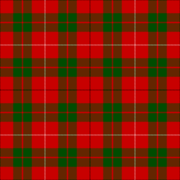 |
This is a Clan Mackinnon tartan that was published in a book called the Vestiarium Scoticum in 1842. Today, there are many different tartans linked to the MacKinnons. |
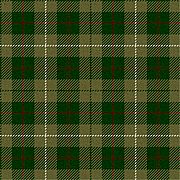 |
This is the Mackinnon Hunting tartan. It's a modern tartan that was officially registered in 1960. It is based on the MacKinnon tartan from the Vestiarium Scoticum. |
 |
The MacKinnon Hunting Modern tartan was registered in 1960. The chief of the clan provided information about the correct patterns for the Clan and Hunting Tartans. |
See also


